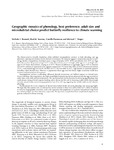Geographic mosaics of phenology, host preference, adult size and microhabitat choice predict butterfly resilience to climate warming
| dc.contributor.author | Bennett, NL | |
| dc.contributor.author | Severns, PM | |
| dc.contributor.author | Parmesan, Camille | |
| dc.contributor.author | Singer, Michael | |
| dc.date.accessioned | 2017-10-29T18:54:26Z | |
| dc.date.available | 2017-10-29T18:54:26Z | |
| dc.date.issued | 2015-01 | |
| dc.identifier.issn | 0030-1299 | |
| dc.identifier.issn | 1600-0706 | |
| dc.identifier.uri | http://hdl.handle.net/10026.1/10114 | |
| dc.description.abstract |
<jats:p>The climate‐sensitive butterfly <jats:italic>Euphydryas editha</jats:italic> exhibited interpopulation variation in both phenology and egg placement, exposing individuals to diverse thermal environments. We measured ‘eggspace’ temperatures adjacent to natural egg clutches in populations distributed across a range of latitudes (36°8′–44°6′) and altitudes (213–3171 m). Eggs laid > 50 cm above the ground averaged 3.1°C cooler than ambient air at 1 m height, while eggs at < 1 cm height averaged 15.5°C hotter than ambient, ranging up to 47°C. Because of differences in egg height, eggs at 3171 m elevation and 20.6°C ambient air experienced mean eggspace temperatures 7°C hotter than those at 213 m elevation and ambient 33.3°C. Experimental eggs survived for one hour at 45°C but were killed by 48°C. Eggs laid low, by positively geotactic butterflies, risked thermal stress. However, at populations where eggs were laid lowest, higher oviposition would have incurred incidental predation from grazers.</jats:p><jats:p>Interpopulation variation in phenology influenced thermal environment and buffered exposure to thermal stress. At sites with hotter July temperatures, the single annual flight/oviposition period was advanced such that eggs were laid on earlier dates, with cooler ambient temperatures. The insects possessed two mechanisms for advancing egg phenology; they could advance timing of larval diapause‐breaking and/or shorten the life cycle by becoming smaller adults. Mean weight of newly‐eclosed females varied among populations from 92 to 285 mg, suggesting that variable adult size did influence phenology.</jats:p><jats:p>Possible options for in situ mitigation of thermal stress include further advancing phenology and raising egg height. We argue that these options exist, as evidenced by current variation in these traits and by failure of <jats:italic>E. editha</jats:italic> to conform to restrictive biogeographic constraints, such as the expectation that populations at equatorial and poleward range limits be confined to higher and lower elevations, respectively. This optimistic example shows how complex local adaptation can generate resilience to climate warming.</jats:p> | |
| dc.format.extent | 41-53 | |
| dc.language | en | |
| dc.language.iso | en | |
| dc.publisher | Wiley | |
| dc.subject | 13 Climate Action | |
| dc.title | Geographic mosaics of phenology, host preference, adult size and microhabitat choice predict butterfly resilience to climate warming | |
| dc.type | journal-article | |
| dc.type | Journal Article | |
| plymouth.author-url | https://www.webofscience.com/api/gateway?GWVersion=2&SrcApp=PARTNER_APP&SrcAuth=LinksAMR&KeyUT=WOS:000347052300006&DestLinkType=FullRecord&DestApp=ALL_WOS&UsrCustomerID=11bb513d99f797142bcfeffcc58ea008 | |
| plymouth.issue | 1 | |
| plymouth.volume | 124 | |
| plymouth.publication-status | Published | |
| plymouth.journal | Oikos | |
| dc.identifier.doi | 10.1111/oik.01490 | |
| plymouth.organisational-group | /Plymouth | |
| plymouth.organisational-group | /Plymouth/Faculty of Science and Engineering | |
| plymouth.organisational-group | /Plymouth/REF 2021 Researchers by UoA | |
| plymouth.organisational-group | /Plymouth/REF 2021 Researchers by UoA/UoA07 Earth Systems and Environmental Sciences | |
| dc.identifier.eissn | 1600-0706 | |
| dc.rights.embargoperiod | Not known | |
| rioxxterms.versionofrecord | 10.1111/oik.01490 | |
| rioxxterms.licenseref.uri | http://www.rioxx.net/licenses/all-rights-reserved | |
| rioxxterms.type | Journal Article/Review |


